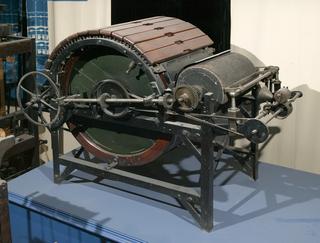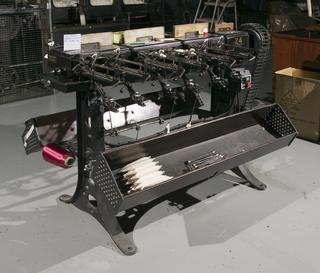
Ring Travellers tin
- PART OF:
- Lancashire textile industry material
- Made:
- 1900 - 1950 in England




Ring Travellers tin made by Cook Ltd
This tin once held thousands of metal ring frame travellers ready to be put to use on a ring spinning textile machine. Being a high-wear part, they needed replacing often and come in various sizes according to the machine they were used on.
Ring spinning, a method of creating cotton yarn, was developed in North America from around 1830. The process involves adding twist to yarn and winding it onto a bobbin at the same time.
Travellers were used to ensure that as the yarn was made, it was under a consistent tension, creating even thread. They also reduced the friction the yarn was under, meaning there were fewer breakages.
The traveller added twist with each revolution of the spindle at speeds of between 4,000 – 12,000 revolutions per minute whilst the spindle turns the bobbin at a constant speed. This process differs from mule spinning, where the yarn is twisted and then wound onto a bobbin in a second process.
Ring spinning machines had advantages over the spinning mule as they could produce more yarn per hour than a mule, could be operated by lower-skilled (and therefore cheaper) workers, produced strong yarn, and up to three could be fitted into the same space as a mule (thus allowing factories to produce higher volumes of yarn). However, the process generally produced a coarser quality of thread and required higher quality (and therefore more expensive) raw cotton.
Details
- Category:
- Textile Industry
- Object Number:
- Y2006.35.2
- Materials:
- metal (unknown)
- Measurements:
-
overall: 85 mm x 75 mm x 100 mm,
- type:
- tin




